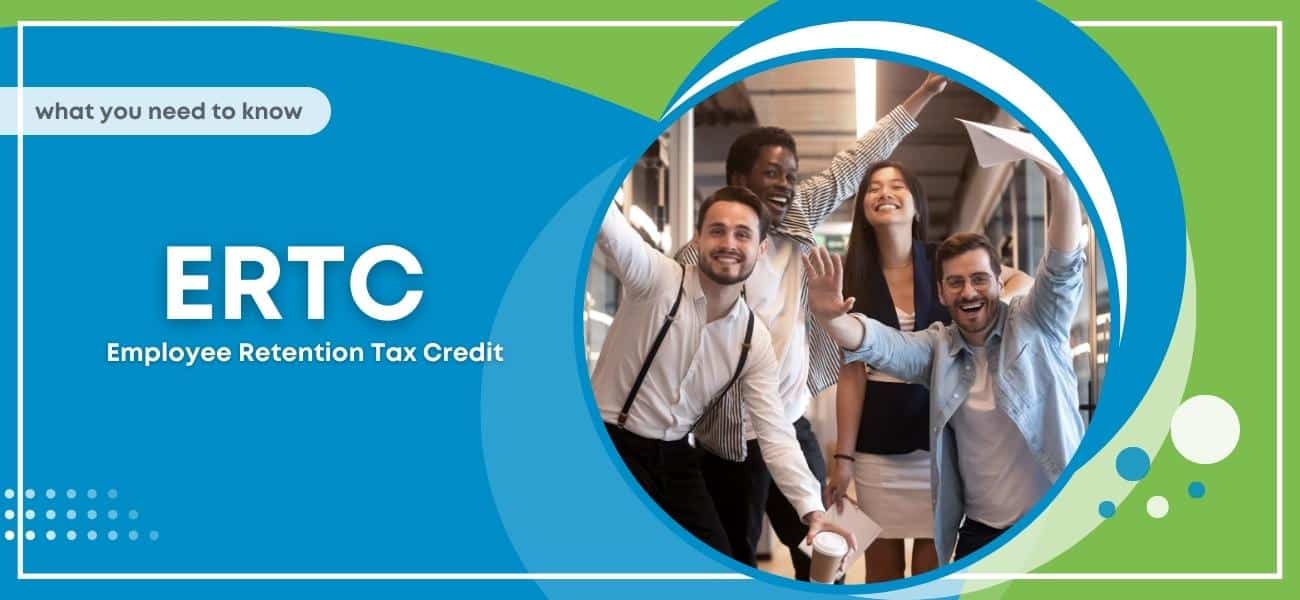Running the financial operations for a nonprofit is a lot like finding your way through a maze on a foggy day. Just as you think you’ve got a hold on your finances, new legislation or a global pandemic like COVID-19 hits, bringing about many changes.
One silver lining in this scenario is the Employee Retention Tax Credit (ERTC), a provision that came to life under the CARES Act in March 2020. It aims to help businesses, including nonprofits, keep their employees on the payroll. But what exactly is the ERTC, and how can your nonprofit benefit from it?
At its core, ERTC helps you pay some of your bills when going through a rough patch, so you don’t have to let go of your most valued assets – your employees. It’s a refundable tax credit against certain employment taxes. While it sounds quite helpful, there are still boxes to tick and papers to file, like with any financial relief program. And although the ERTC program has officially ended, businesses can still claim the credit retroactively if they qualify for the 2020 or 2021 quarters.
As we journey through the essentials of the ERTC in this article, we’ll shed light on what it means for your nonprofit, how to determine your eligibility, and even the ins and outs of the filing process. Importantly, we’ll underline why every nonprofit should take advantage of it. If you’re ready, let’s dive right in!
What is the Employee Retention Tax Credit?

Source: Pexels
In March of 2020, when COVID-19 started inflicting not only health challenges on the world but significant challenges for businesses and organizations, too, a relief bill named the Coronavirus Aid, Relief, and Economic Security (CARES) Act was enacted. One of the key principles of this Act was the creation of the Employee Retention Tax Credit.
Mainly designed to prevent massive layoffs, especially in sectors affected by lockdowns and public health restrictions, the ERTC is essentially a refundable tax credit set against certain employment taxes. To simplify, it’s a sum of money that employers can subtract from the total employment tax they owe. If the credit is larger than what you owe, you get the remaining portion refunded.
While the ERTC applies broadly to businesses, it’s especially beneficial for nonprofits because of their unique financial situation. Nonprofits usually operate on tight budgets and rely heavily on grants, private funding, and donations, streams which are likely to have decreased no thanks to uncertainties brought by the pandemic.
Initially, the ERTC provided a credit of 50% on up to $10,000 in wages paid per employee between March 12th and December 31st, 2020. But with the introduction of the Consolidated Appropriations Act in 2021, things became even more favorable for organizations. The credit was now available once every quarter in 2021 and included 70% on up to $10,000 in wages paid per employee. That amendment meant more financial support available if you were eligible.
Should your nonprofit encounter serious financial difficulties—especially those leading to a reduction in operations or threat of layoffs—the ERTC could serve as a significant lifeline.
What Can ERTCs Do For Nonprofits?
When times are tough – say, the need for service is high and funding is uncertain, the ERTC can act as a serious lifeline for struggling nonprofits.
Provide Financial Aid
The most significant thing ERTC offers is financial relief, which can directly influence a nonprofit’s bottom line. The fact that this credit is refundable means that you don’t just get to shave off your tax bill but possibly also gain a profit. For example, even if the ERTC amount is higher than the employment taxes you owe for that quarter, you can claim the entire amount regardless.
The government doesn’t just waive certain employment taxes but also ensures nonprofits get ‘paid’ to keep employees on their payroll. Anything over your taxes due comes back to you as a nice refund.
According to the National Federation of Independent Business (NFIB), only 8% of businesses used the ERTC in 2020. This financial gain is essential for cushioning nonprofits against rough economic times without wasting their savings.
Promoting Operational Continuity
The impact of up to $28,000 per employee that can be saved or used elsewhere in the organization can be transformational for many nonprofits. By helping nonprofits retain their employees, the ERTC helps with operational continuity. Workforce stability can play a huge role in determining a nonprofit’s ability to weather a crisis and continue with its mission.
Let’s look at a nonprofit that provides shelter and services to homeless individuals. If this nonprofit is forced to cut its staff because of financial strains, not only will their services become stretched, but the people depending on them could be left stranded. Claiming the ERTC allows nonprofits not to have to make the hard decision between preserving their mission or their workforce.
Attracting Donors Through Financial Sustainability
Besides financial and operational stability, ERTC can also serve as an encouragement to donors through reputation and trust. Donors typically want the reassurance that the nonprofits they choose to support are sustainably run and are using all available resources to withstand any issues. When you demonstrate that your organization takes advantage of government aids such as the ERTC, you can win over high-paying, respected donors.
While it may seem complicated and tedious to apply for at first, understanding and applying for ERTC can have plenty of benefits in the grand scheme of things.
Is Your Nonprofit Eligible for ERTCs?
Any nonprofit operating during any part of the year 2020 or 2021 can be eligible for ERTC, regardless of size. That includes public charities, private foundations, and even most faith-based organizations, as long as you had employees on the payroll.
Now come the more specific requirements. To qualify for ERTC, the nonprofit must have at least one of these:
Revenue Impact
To qualify for ERTC, a nonprofit must have experienced a substantial decline in gross receipts during the eligible periods throughout 2020 or 2021. In 2020, this decline should be at least 50% for any quarter when compared to the same quarter in 2019. In 2021, the slump should be at least 20% for any quarter compared to the same quarter in 2019.
Full or Partial Suspension
Your nonprofit should have had its operations partially or fully suspended during 2020 or the first three calendar quarters of 2021 due to a government order related to COVID-19. This doesn’t mean a complete shutdown; any disruption in normal operations can count. For example, a foundation that couldn’t carry out its annual fundraiser due to social distancing regulations may qualify.
Certain Number of Full-Time Employees
Another criterion to determine the size of the credit is the number of full-time employees (FTEs). In 2020, if a nonprofit had 100 or fewer FTEs, it could claim the credit for wages paid to all employees. Beyond this limit, the organization can only claim ERTC for wages paid to employees not providing services due to a suspension or decline in business. For 2021, the number was increased to 500 FTEs.
Proof of Being a Recovery Startup Business
If a nonprofit began its operation after February 15, 2020, and has an annual gross receipt of up to $1 million, it’s considered a Recovery Startup Business for ERTC. These businesses are eligible to claim the credit for the third and fourth quarters of 2021, with a maximum cap of $50,000 per quarter. To qualify, the nonprofit needs to provide documentation verifying its inauguration date and annual gross receipts.
Even employers who received Paycheck Protection Program (PPP) loans can qualify, although there are important considerations to ensure there’s no “double-dipping.”
When claiming the ERTC retroactively for 2020, don’t forget that the rules were different compared to 2021. The percentage of wages that can be claimed and the thresholds for what constitutes a significant decline in gross receipts were more strict.
How Nonprofits Can File for the Employee Retention Tax Credit
If you believe you qualify and are ready to claim the ERTC, you might be wondering how you file for it. The answer lies with the IRS, specifically with federal employment tax returns. For most nonprofits, you can claim the ERTC retroactively by using Form 941-X – the Adjusted Employer’s Quarterly Federal Tax Return or Claim for Refund.
Along with the required documentation on wages and health plan expenses, IRS guides also need you to provide a statement explaining how you calculated the credit, evidence of any governmental orders of a shutdown, and how it impacted your operations.
While you might already be “late” on filing the ERTC, you’ll be happy to know that you have until April 15th, 2024, to file for 2020 and April 15th, 2025, to file for 2021. And as of now, for the credits related to 2021 wages, nonprofits can claim the ERTC quarterly, which means four opportunities to claim during the year instead of waiting until the end of the year.
Many nonprofits handle the process independently, but getting help from an experienced professional is a good idea. Tax specialists are well-versed in tax formalities and clauses, and their expertise could help avoid common mistakes, saving you the hassle of refiling.
LTD Global is a highly proficient international accounting and administrative services firm that can help your nonprofit with ERTC tax filing. Having been in operation since 2003, this renowned company has the specialized knowledge to help nonprofits and small and midsize businesses that larger corporations may not.
Our team of experts, with their impressive breadth of experience and knowledge, will ensure your nonprofit fully leverages the benefits of ERTC. We can provide comprehensive guidance right from assessing eligibility to effectively using the tax credit.
The ERTC: Empowering Nonprofits Amid Challenges
From our journey through the maze of ERTC, we conclude with one significant takeaway: the Employee Retention Tax Credit is an invaluable tool for nonprofits. It serves to ease financial pressures, letting nonprofit organizations focus on their mission and purpose. Above all, it is an offering from the government to help keep the organizations running that operate selflessly for the betterment of society.
While the ERTC asks nonprofits to keep their bookkeeping skills in check and learn a few IRS terms along the way, the financial rewards are significant. The sheer amount that nonprofits can save per year can make a huge difference in operations, budgets, and morale.
With all the challenges COVID-19 has presented, claiming the ERTC retroactively might give your organization some relief and help fortify your organization’s financial health.

